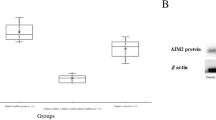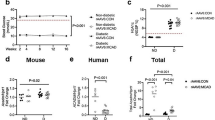Abstract
Ciliary neurotrophic factor (CNTF), which is a neural peptide, has been reported to confer cardioprotective effects. However, whether CNTF-based gene delivery could prevent cardiac remodeling in diabetes mellitus remains unknown. In this study, we used adeno-associated viral vector serotype 9 (AAV9)-based cardiac gene delivery to test the effects of CNTF overexpression on adverse ventricular remodeling in streptozotocin-induced type 1 diabetic mice models. Postnatal (P3-P10) mice were peritoneally injected with AAV9 recombinant virus carrying the CNTF gene or EGFP gene. Then, type 1 diabetic models were established by peritoneal injection of streptozotocin (200 mg/kg) in 7-week-old female mice injected with AAV9. 4 weeks later after the establishment of type 1 diabetes mellitus, mouse hearts were removed to assess the degree of cardiac remodeling. We found that CNTF overexpression in mouse cardiomyocytes exacerbated cell apoptosis and cardiac fibrosis coupled with an increased inflammatory response in the heart tissue of diabetic female mice. Taken together, our results suggested that cardiac CNTF gene delivery may not be beneficial in alleviating adverse cardiac remodeling in type 1 diabetes female mice.



Similar content being viewed by others
Data Availability
The datasets used and analyzed during the current study are available from the corresponding author on reasonable request. All data generated or analyzed during this study are included in this published article.
Code Availability
No code was generated or used during the study.
Change history
08 December 2021
A Correction to this paper has been published: https://doi.org/10.1007/s12012-021-09711-9
References
Zhong, P., Wu, L., Qian, Y., Fang, Q., Liang, D., Wang, J., Zeng, C., Wang, Y., & Liang, G. (1852). Blockage of ROS and NF-κB-mediated inflammation by a new chalcone L6H9 protects cardiomyocytes from hyperglycemia-induced injuries. Biochimica et Biophysica Acta, 2015, 1230–1241. https://doi.org/10.1016/j.bbadis.2015.02.011
Zhong, P., Zeng, G., Lei, C., Tian, G., Ouyang, S., Liu, F., & Peng, J. (2021). Ciliary neurotrophic factor overexpression protects the heart against pathological remodelling in angiotensin II-infused mice. Biochemical and Biophysical Research Communications, 547, 15–22. https://doi.org/10.1016/j.bbrc.2021.01.111
Fischer, P., & Hilfiker-Kleiner, D. (2007). Survival pathways in hypertrophy and heart failure: The gp130-STAT3 axis. Basic Research in Cardiology, 102, 279–297. https://doi.org/10.1007/s00395-007-0658-z
Zheng, K., Zhang, Q., Sheng, Z., Li, Y., & Lu, H. H. (2018). Ciliary neurotrophic factor (CNTF) protects myocardial cells from oxygen glucose deprivation (OGD)/re-oxygenation via activation of Akt-Nrf2 signaling. Cellular Physiology and Biochemistry, 51, 1852–1862. https://doi.org/10.1159/000495711
Raju, S. V., Zheng, M., Schuleri, K. H., Phan, A. C., Bedja, D., Saraiva, R. M., Yiginer, O., Vandegaer, K., Gabrielson, K. L., O’Donnell, P., Berkowitz, D. E., Barouch, L. A., & Hare, J. M. (2006). Activation of the cardiac ciliary neurotrophic factor receptor reverses left ventricular hypertrophy in leptin-deficient and leptin-resistant obesity. Proceedings of the National Academy of Sciences of the United States of America, 103, 4222–4227. https://doi.org/10.1073/pnas.0510460103
Bise, T., de Preux-Charles, A. S., & Jaźwińska, A. (2019). Ciliary neurotrophic factor stimulates cardioprotection and the proliferative activity in the adult zebrafish heart. NPJ Regenerative Medicine, 4, 2. https://doi.org/10.1038/s41536-019-0064-9
Johansen, A. K., Molenaar, B., Versteeg, D., Leitoguinho, A. R., Demkes, C., Spanjaard, B., de Ruiter, H., Akbari Moqadam, F., Kooijman, L., Zentilin, L., Giacca, M., & van Rooij, E. (2017). Postnatal cardiac gene editing using CRISPR/Cas9 with AAV9-mediated delivery of short guide RNAs results in mosaic gene disruption. Circulation Research, 121, 1168–1181. https://doi.org/10.1161/circresaha.116.310370
Prasad, K. M., Xu, Y., Yang, Z., Acton, S. T., & French, B. A. (2011). Robust cardiomyocyte-specific gene expression following systemic injection of AAV: In vivo gene delivery follows a Poisson distribution. Gene Therapy, 18, 43–52. https://doi.org/10.1038/gt.2010.105
Lemper, M., De Groef, S., Stangé, G., Baeyens, L., & Heimberg, H. (2016). A combination of cytokines EGF and CNTF protects the functional beta cell mass in mice with short-term hyperglycaemia. Diabetologia, 59, 1948–1958. https://doi.org/10.1007/s00125-016-4023-3
Rezende, L. F., Santos, G. J., Carneiro, E. M., & Boschero, A. C. (2012). Ciliary neurotrophic factor protects mice against streptozotocin-induced type 1 diabetes through SOCS3: The role of STAT1/STAT3 ratio in β-cell death. The Journal of Biological Chemistry, 287, 41628–41639. https://doi.org/10.1074/jbc.M112.358788
Rezende, L. F., Vieira, A. S., Negro, A., Langone, F., & Boschero, A. C. (2009). Ciliary neurotrophic factor (CNTF) signals through STAT3-SOCS3 pathway and protects rat pancreatic islets from cytokine-induced apoptosis. Cytokine, 46, 65–71. https://doi.org/10.1016/j.cyto.2008.12.014
Zhou, Q., Chen, P., Di, G., Zhang, Y., Wang, Y., Qi, X., Duan, H., & Xie, L. (2015). Ciliary neurotrophic factor promotes the activation of corneal epithelial stem/progenitor cells and accelerates corneal epithelial wound healing. Stem Cells (Dayton, Ohio), 33, 1566–1576. https://doi.org/10.1002/stem.1942
Chowdhury, S. R., Saleh, A., Akude, E., Smith, D. R., Morrow, D., Tessler, L., Calcutt, N. A., & Fernyhough, P. (2014). Ciliary neurotrophic factor reverses aberrant mitochondrial bioenergetics through the JAK/STAT pathway in cultured sensory neurons derived from streptozotocin-induced diabetic rodents. Cellular and Molecular Neurobiology, 34, 643–649. https://doi.org/10.1007/s10571-014-0054-9
Schlichtenbrede, F. C., MacNeil, A., Bainbridge, J. W., Tschernutter, M., Thrasher, A. J., Smith, A. J., & Ali, R. R. (2003). Intraocular gene delivery of ciliary neurotrophic factor results in significant loss of retinal function in normal mice and in the Prph2Rd2/Rd2 model of retinal degeneration. Gene Therapy, 10, 523–527. https://doi.org/10.1038/sj.gt.3301929
Ma, M., Xu, Y., Xiong, S., Zhang, J., Gu, Q., Ke, B., & Xu, X. (2018). Involvement of ciliary neurotrophic factor in early diabetic retinal neuropathy in streptozotocin-induced diabetic rats. Eye (London, England), 32, 1463–1471. https://doi.org/10.1038/s41433-018-0110-7
Guo, X., & Liu, X. (2017). Nogo receptor knockdown and ciliary neurotrophic factor attenuate diabetic retinopathy in streptozotocin-induced diabetic rats. Molecular Medicine Reports, 16, 2030–2036. https://doi.org/10.3892/mmr.2017.6850
Xie, L., Yin, Y., & Benowitz, L. (2021). Chemokine CCL5 promotes robust optic nerve regeneration and mediates many of the effects of CNTF gene therapy. Proceedings of the National Academy of Sciences of the United States of America, 118, e2017282118. https://doi.org/10.1073/pnas.2017282118
Xue, W., Cojocaru, R. I., Dudley, V. J., Brooks, M., Swaroop, A., & Sarthy, V. P. (2011). Ciliary neurotrophic factor induces genes associated with inflammation and gliosis in the retina: A gene profiling study of flow-sorted, Müller cells. PLoS ONE, 6, e20326. https://doi.org/10.1371/journal.pone.0020326
Hu, Z., Deng, N., Liu, K., Zhou, N., Sun, Y., & Zeng, W. (2020). CNTF-STAT3-IL-6 axis mediates neuroinflammatory cascade across schwann cell-neuron-microglia. Cell Reports, 31, 107657. https://doi.org/10.1016/j.celrep.2020.107657
Wang, Z., Zhu, T., Qiao, C., Zhou, L., Wang, B., Zhang, J., Chen, C., Li, J., & Xiao, X. (2005). Adeno-associated virus serotype 8 efficiently delivers genes to muscle and heart. Nature Biotechnology, 23, 321–328. https://doi.org/10.1038/nbt1073
Fourny, N., Beauloye, C., Bernard, M., Horman, S., Desrois, M., & Bertrand, L. (2021). Sex differences of the diabetic heart. Frontiers in Physiology, 12, 661297. https://doi.org/10.3389/fphys.2021.661297
Du, X. J. (2004). Gender modulates cardiac phenotype development in genetically modified mice. Cardiovascular Research, 63, 510–519. https://doi.org/10.1016/j.cardiores.2004.03.027
Jia, C., Brown, R. W., Malone, H. M., Burgess, K. C., Gill, W. D., Keasey, M. P., & Hagg, T. (2019). Ciliary neurotrophic factor is a key sex-specific regulator of depressive-like behavior in mice. Psychoneuroendocrinology, 100, 96–105. https://doi.org/10.1016/j.psyneuen.2018.09.038
Funding
This work was supported by financial support from Wuhan University (Grant number: 2042019kf0074) and jointly supported by the National Natural Science Foundation of China (No. 81401304), the Natural Science Foundation of Hubei Province, China (No. 2019CFB621), the Health Commission of Hubei Province and Wuhan University of Science and Technology Joint Foundation (WJ2019H219).
Author information
Authors and Affiliations
Contributions
PZ and HSD conceptualized the study and designed the experiments. PZ, JYP, and TL perfumed experiments and researched and analyzed data. PZ wrote the manuscript with all co-authors revising it critically for important intellectual content. All authors approved the final version of the manuscript.
Corresponding authors
Ethics declarations
Conflict of interest
The authors declare that they have no conflicts of interest.
Ethical Approval
The animal experiments were approved by the ethics committee of Wuhan University. This study conforms to the NIH Guide for the Care and Use of Laboratory Animals (NIH publication No.85-23, revised 1996).
Additional information
Communicated by Martin Štěrba.
Publisher's Note
Springer Nature remains neutral with regard to jurisdictional claims in published maps and institutional affiliations.
The original online version of this article was revised: “Hua-sheng Ding is the co-corresponding author of the article”.
Rights and permissions
About this article
Cite this article
Zhong, P., Peng, J., Liu, T. et al. AAV9-Mediated Cardiac CNTF Overexpression Exacerbated Adverse Cardiac Remodeling in Streptozotocin-Induced Type 1 Diabetic Models. Cardiovasc Toxicol 22, 88–96 (2022). https://doi.org/10.1007/s12012-021-09706-6
Received:
Accepted:
Published:
Issue Date:
DOI: https://doi.org/10.1007/s12012-021-09706-6




